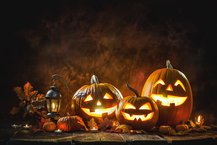Halloween is a holiday we are all familiar with, yet few of us are aware of its extensive history. It originated as the most well-known of Pagan festivals and is widely celebrated in the Western World today by Pagans and non-Pagans alike. The older name, “Samhain” is Celtic and means Summer’s End. As Christianity made its way through Europe, ‘All Hallows Day’ overrode the traditional Pagan festivities in commemoration of their blessed dead. Finally, Western culture in more recent decades has adopted the age-old traditions and turned them into the spooky, family-friendly festival that we are so fond of today. Outlined below is a more extensive explanation of the fascinating history of Halloween.
Pagans and Celts
Samhain is one of the four Greater Sabbats or high holidays which are also known as “cross-quarter days”. The low holidays or lesser sabbats are comprised of the four quarter days; the solstices and equinoxes, which are four important astronomical points for the Earth. However, of all the high holidays, Samhain must surely be the biggest festival as far as Pagans and Witches are concerned. It is the Pagan New Year in the same way that it was the New Year for the Celtic people from whom many Pagans draw their beliefs and traditions.
The Celts would bring in their livestock from the pasture and some were slaughtered for winter supplies of meat. Grain had been gathered and processed and the last fruit was picked but any left on the trees after Samhain had to stay there in order to feed any passing spirit. Hired farm workers would return home and wandering bards would find a place to stay over the winter.
Wood would be cut and everyone would prepare themselves for the long, dark and quiet winter months. The labour of the Summer months would now cease and, if they had enjoyed a good harvest, Winter would be well provided for. If, however, the harvest had been poor, Winter would have been an unpleasant if not scary prospect of privation and hunger.
Therefore, at the very end of Autumn a great feast was held before Winter set in. This was the festival of Samhain. There would be great bonfires lit and an abundance of good food, such as roast meats, fresh fruit and vegetables. It was a time of celebration, reflection and anticipation; looking back and looking forward. In addition, the people would assemble and go from home to home, singing traditional songs – carols – which would be remarkably similar to Yuletide wassailing.
Christianity
The name “Halloween” is used because Christians adopted the various Pagan festivals previously mentioned into their own in order to appease the common people and ultimately to convert them to Christianity. This is why there are so many Christian festivals which lie on top or next to older Pagan festivals. Halloween is no exception. The Christians decided to commemorate the blessed dead; the hallowed (meaning holy) and therefore this day is also known in the Christian calendar as ‘All Hallows Day’ or ‘All Souls Day’ and it falls on November 1st. From this, we get the word Halloween; the night before All Hallows Evening. Therefore, Christians also recognised that this time of year was in remembrance of the dead, however what the Church could not condone was the use of divination to predict the future and nor would it accept that one could communicate with the spirit world.
Now we have looked at the intricate history of Halloween, let’s delve into some of the traditions associated with the holiday and explore how they have come about.
Spirits of the Dead
Samhain was originally a Celtic Druidic festival, and its opposite festival is Beltane, the start of Summer. It is a time when the veil between the mortal world and the spirit world, the “Sídh”, was very thin; spirits and mortals could move between both worlds – only on the night of 31st October.
In Ireland, the Sídh mounds (burial mounds) were opened at Samhain and lit with burning torches so that the spirits would find their way out to visit their living loved ones to dine or just to visit. Celtic people often set extra places at the table in case a deceased loved one should show up. The offering of hospitality and food to the spirits was very important as no one wanted to offend them.
The Celts and generations after them always believed that there were malevolent spirits let loose on the world at this time also; wicked imps or sprites whose intention was to cause mayhem and play tricks on people. In Scotland, there was a tradition that men would carry burning torches around the boundaries of their land in order to protect their loved ones from evil spirits out to cause trouble.
However, at day break, the spirits would need to return to the Underworld and thus the gateway between them and the mortal world was closed once more for another year.
Trick or Treat
Trick or Treat is really a very old custom, perhaps predating Christianity. The Celts are believed to have dressed in costumes to represent their gods at Samhain, it is also thought that they would have gone to different dwellings to collect food as an offering to the gods. In addition, children may well have collected firewood from different homes for the communal bonfire.
As the Celtic New Year would have been a time for celebration it is likely people became drunk and played tricks on each other. The drink was possibly their “treat”.
A Christian tradition from medieval times was to make “soul cakes”. These were simple puddings made of bread and dried fruit. Children would go out “souling” which involved begging at different homes for soul cakes. Every time a child received a cake he or she would have to say a prayer for the dead in order to help the souls find their way to heaven.
Children today often dress up as witches with green faces when they go trick or treating. This is an interesting legacy from an old Scottish legend. The Scots believed that a hag called Cailleach arose at Samhain to walk about. Her face was either grey or green because as an evil being, she was seen in a state of permanent decomposition. She was feared but then, the ghouls and ghosts of Halloween have always meant to be scary. There is something perverse in the human psyche which enjoys being scared it seems.
Jack O’Lantern
Perhaps one of the most prevailing images from Halloween is the malevolent faced pumpkin, lit from inside with a candle. This custom has roots in English and Irish history; as pumpkins are not an indigenous species to the British Isles, it is likely gourds or turnips were used. These were scoped out and carved with scary faces. Then, just as we do today, these were illuminated with candles and carried around as a guiding light through the darkness – the scary face was there to frighten away any evil spirits.
The name Jack O’Lantern comes from Ireland and is derived from a folk tale about the miser “Stingy Jack” who managed to trick the Devil by convincing Him to climb a tree. Whilst the Devil was up the tree, Jack carved Christian crosses in the tree trunk so that the Devil could not get down again. The Devil persuaded Jack to let him down by promising he would not go to Hell. When Jack died, he was refused entry to both Heaven and Hell and thus he still walks around the Earth as a spirit in limbo. The Devil threw Jack a glowing coal from Hell and so Jack placed it in a hollowed turnip in order to light his way in the night.
Jack O’Lanterns have been carved for hundreds of years in the British Isles as a means of scaring away evil spirits. It was only when settlers arrived in America that pumpkins were used. It is easy to see why pumpkins are so much more popular today – they are much larger and much easier to hollow out than a hard turnip.
Divination
As we all know, bobbing for apples is a popular Halloween pastime and involves tying a person’s hands behind their back as they duck their head in water to pick out an apple. But looked at in another light, this may be reminiscent of a Pagan initiation rite or baptism. Bobbing for apples was also a form of simple divination; a girl might secretly choose and apple and watch as the boys bobbed for apples whichever boy picked out her apple would be her future husband.
This night was also a time for divination, in other words looking into the future, whether it be by tea leaves or tarot cards. There are a number of traditional folk magicks which could be performed, for example, if a girl wanted to know what her future husband would look like, she would cut an apple down the middle and eat it by candlelight at midnight in front of a mirror. His face would then appear in the mirror.
No matter one’s belief system nor how they wish to celebrate the holiday of Halloween, it is important that we are aware of the intricate and layered history attached to this prominent day. The various adaptations, from Pagan Samhain to Christian All Hallows Day only goes to show just how profound this seasonal shift is for various different cultures. Specific practices and beliefs aside, it cannot be denied that the Halloween season is a season of remarkable change and spiritual importance. For this reason, remember to enjoy the festivities with loved ones and acknowledge the wealth of fascinating history associated with Halloween.
Find the best Psychic Advisor in our Unique Search Tool
We have selected the most relevant psychics for this article, you can connect with any of them and get accurate advice on this subject.









